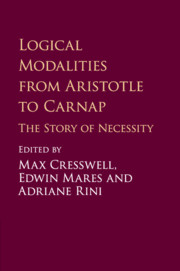Book contents
- Frontmatter
- Contents
- List of Figures and Tables
- List of Contributors
- List of Abbreviations
- Introduction
- 1 Aristotle on the Necessity of the Consequence
- 2 Aristotle on One- Sided Possibility
- 3 Why Does Aristotle Need a Modal Syllogistic?
- 4 Necessity, Possibility, and Determinism in Stoic Thought
- 5 Necessity in Avicenna and the Arabic Tradition
- 6 Modality without the Prior Analytics: Early Twelfth Century Accounts of Modal Propositions
- 7 Ockham and the Foundations of Modality in the Fourteenth Century
- 8 Theological and Scientific Applications of the Notion of Necessity in the Mediaeval and Early Modern Periods
- 9 Locke and the Problem of Necessity in Early Modern Philosophy
- 10 Leibniz's Theories of Necessity
- 11 Leibniz and the Lucky Proof
- 12 Divine Necessity and Kant's Modal Categories
- 13 Charles Sanders Peirce on Necessity
- 14 The Development of C. I. Lewis's Philosophy of Modal Logic
- 15 Carnap's Modal Predicate Logic
- Bibliography
- Index
13 - Charles Sanders Peirce on Necessity
Published online by Cambridge University Press: 05 September 2016
- Frontmatter
- Contents
- List of Figures and Tables
- List of Contributors
- List of Abbreviations
- Introduction
- 1 Aristotle on the Necessity of the Consequence
- 2 Aristotle on One- Sided Possibility
- 3 Why Does Aristotle Need a Modal Syllogistic?
- 4 Necessity, Possibility, and Determinism in Stoic Thought
- 5 Necessity in Avicenna and the Arabic Tradition
- 6 Modality without the Prior Analytics: Early Twelfth Century Accounts of Modal Propositions
- 7 Ockham and the Foundations of Modality in the Fourteenth Century
- 8 Theological and Scientific Applications of the Notion of Necessity in the Mediaeval and Early Modern Periods
- 9 Locke and the Problem of Necessity in Early Modern Philosophy
- 10 Leibniz's Theories of Necessity
- 11 Leibniz and the Lucky Proof
- 12 Divine Necessity and Kant's Modal Categories
- 13 Charles Sanders Peirce on Necessity
- 14 The Development of C. I. Lewis's Philosophy of Modal Logic
- 15 Carnap's Modal Predicate Logic
- Bibliography
- Index
Summary
Introduction
Necessity is a touchstone issue in the thought of Charles Peirce, not least because his pragmatist account of meaning relies upon modal terms. In contrast to the highly influential positivist currents in twentieth century philosophy in which “fact-stating” is paramount and put in the indicative mode, Peirce famously advised us to clarify the meaning of our terms using “would-bes,” not “will-bes” (CP 5.453; 5.457, 1905). Peirce's pragmatic maxim is that we must look to the practical effects of our concepts, and the practical effects he is concerned with are those that would occur under certain circumstances, not those that will actually occur. This effectively translates every meaningful term into a set of hypothetical conditionals. Thus, for instance, the fact that a table is hard means (among other things) that if I were to rest a dinner plate on it, the plate would not fall through to the floor (Misak 2013, 29ff; Hookway 1985).
Peirce thought deeply about necessity in all its aspects, and this is one of the areas of his work with as-yet-untapped insights. Discussions of necessity show up from his earliest philosophical writings based on Kant's logic and its table of 12 categories (one row of which is, of course, explicitly modal) to the end of his life, when he was working out a forest of distinctions in semiotics. His thoughts on modality also span a multitude of philosophical areas – informing his work on mathematics, logic, metaphysics, philosophy of science, and ethics.
His views on the topic have some intriguing features. His modal epistemology understands logical form as essentially structural, thus requiring representation by iconic or diagrammatic signs. Peirce made good on this commitment, developing the Existential Graphs, a diagrammatic logical notation, which is still understudied by mainstream logicians. His metaphysics differs from that of many nineteenth century peers in flatly denying “necessitarianism” (determinism) and arguing for real chance. He also distinguished between a kind of necessity that corresponds to the compulsion given by one billiard ball to another (which we might refer to in Peircean terms as a “Secondness Necessity”) and a kind of necessity that corresponds to a real universal (“Thirdness Necessity”), whereas in contemporary philosophy the two are routinely conflated.
- Type
- Chapter
- Information
- Logical Modalities from Aristotle to CarnapThe Story of Necessity, pp. 256 - 278Publisher: Cambridge University PressPrint publication year: 2016

